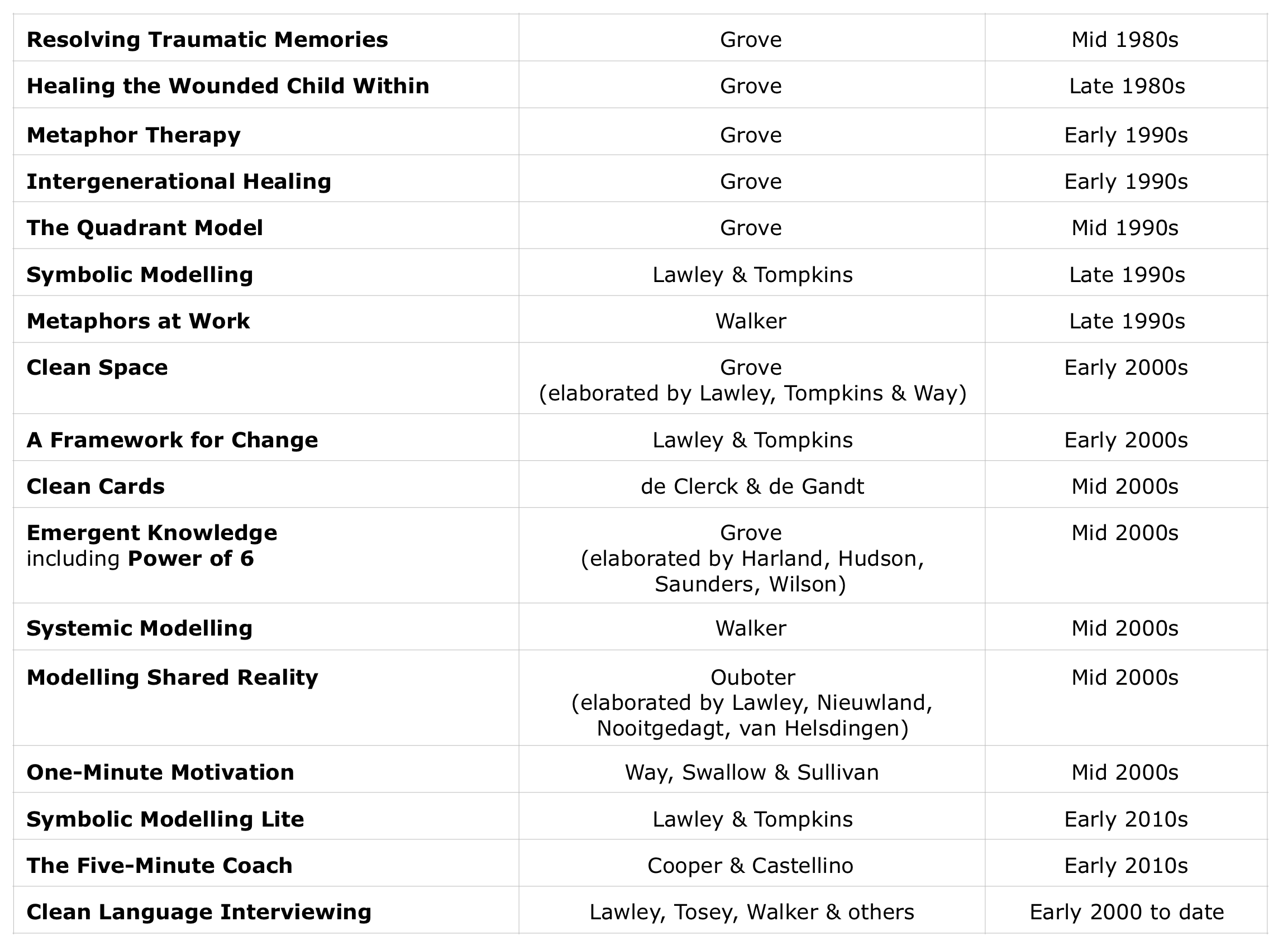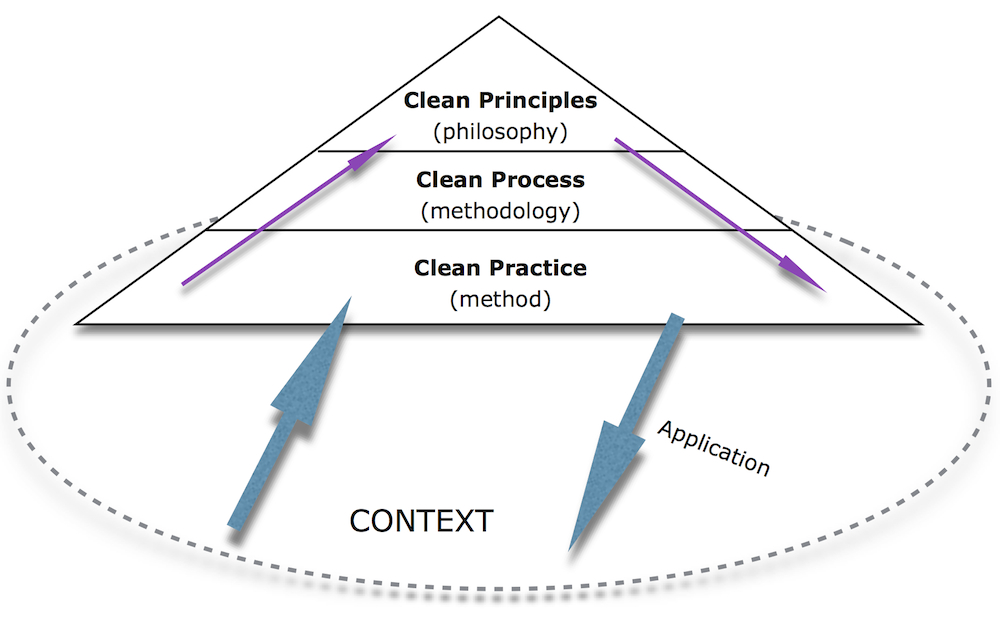I was recently asked “What constitutes Clean Language?”. A fairly straightforward question you might think until you go into it more deeply. It is an interesting question because the ways people have used the term “Clean Language” have proliferated since David Grove coined it in the early 1980s.
The obvious answer is that Clean Language consists of the set of clean questions and the delivery method devised by David Grove. While this makes sense at first sight, there are complications. Firstly, David evolved the question set considerably over his 30 years of innovation including devising ‘clean instructions’ for his Clean Space process. Secondly, only parts of the question set are relevant to particular processes. Thirdly, there are many ways to categories the questions. Penny Tompkins and I published our first description of Clean Language in 1997 and since then we have made several adjustments to the way we present the questions.[1] Lastly, sometimes a novel clean question needs to be created, one tailored to the particular context.
What is and what is not ‘clean’ cannot be rigidly defined. Phil Swallow and Wendy Sullivan have referred to this variability as a “clean continuum”.[2] Since we worked with Caitlin Walker training police interviewers in 2002 we’ve noticed that what constitutes a clean question varies with each application area. For example a police officer investigating a car accident is entitled to cleanly ask “Who was driving the car?” or “What time did the incident occur?” since these can be presupposed in the physical world. They would not be clean if the accident occurred in someone’s metaphor landscape. We therefore use the term contextually clean to distinguish variations from David Grove’s original application of Clean Language to psychotherapy.[3]
In the last 10 or so years the pace of innovation involving clean approaches has been accelerating. David Grove introduced Clean Space and Emergent Knowledge.[4] We introduced A Framework for Change, Clean Space Lite and Symbolic Modelling Lite; and Clean Language has been incorporated into or combined with dozens of other practices and applications. Below is a list of clean processes in approximate order of when they were first developed and with the name of the originator(s):


My dictionary defines ‘a method’ as a particular form of procedure for accomplishing something, especially a systematic or established one. Whereas ‘a methodology’ is system of methods used in a particular area of study or activity. Thus methodologies are at a higher logical level than methods. Clean Language is the primary method used in most of the methodologies listed above.
In 1998 David Grove defined his Philosophy and Principles of Clean Language.[6] These principles do not look anything like his clean questions. And nor do the Principles of Symbolic Modelling we summarise at the end of Chapter 2 of Metaphors in Mind (pp. 45-47).[7] This is because ‘a philosophy’ contains the overarching principles and assumptions about how to use a method within the process of a chosen methodology.
Recognising the difference between these levels is fairly easy:
A practice or method involves behaviour you can see and hear moment by moment.
A process or methodology takes place over time. It involves a number of stages/phases which when taken together make up a coherent approach. It has a purpose and provides a framework for selecting which behaviours to do when.
The principles of a philosophy are an abstract set of notions and principles that guide the design and implementation of a methodology across contexts, as well as the practitioner, especially in unfamiliar situations.
Consider how long it takes to become competent at using each level. People can get good at using Clean Language with a few days training. It takes more time and effort to get good at using one of the clean methodologies (some of them substantially more time). And it usually takes several years to have the clean principles so fully in the muscle that you are able to work in new contexts and create new processes.
The levels triangle also makes clear that it is possible to use Clean Language with other-than-clean processes, and conversely to use some ‘non-clean’ questions within a clean methodology (note: I am not recommending it!). However if the practice and the process are not aligned with a clean philosophy then whatever happens, it is probably not going to be clean.
What then is ‘Clean’?
This leads me to another point. The word ‘clean’ started as a metaphor and is more and more being used as a metonymy – a part that stands for the whole. In this sense ‘Clean’ has become a title or generic name for the whole field.[8] I’m ok with this, and it is a good example of how language evolves through usage. However conflating levels by calling any of the growing number of processes “Clean Language” doesn’t help. I’d call this a Batesonian logical-typing error. Clean Language exists as behaviours which can be observed and described directly. She said this, he did that, etc. A methodology is more abstract. It is a how-to process that needs be suited to a context, which is why I don’t think processes should be called “Clean Language” but instead given their own name while acknowledging the source. For example, we often refer to “Symbolic Modelling using the Clean Language of David Grove”.
To conclude, Penny and I summarised the function and components of Clean Language in two pages of Metaphors in Mind (pp. 282-283). While this summary may not be the be-all and end-all of what constitutes Clean Language, it still specifies the core of the method. I therefore think that a person needs to be using either a substantial amount of that core, or a substantial part of what they do needs to involve a subset (e.g. One-Minute Motivation uses just four questions, three of which come from classic Clean Language), before they can legitimately say they are “using Clean Language”. Just asking one or two clean questions in the middle of whatever else is done, while useful, would not, in my opinion, be enough to call it a clean process. To avoid confusion and remain respectful to David Grove I would suggest calling the process something other than Clean Language.
Note: The original blog was updated 9 June 2015: three extra methodologies were added to the table; the diagram was modified; and the levels terminology amended.
References
1 Less is More … The Art of Clean Language, Penny Tompkins and James Lawley, Rapport 35, February 1997.
Clean Language Revisited: The evolution of a model, James Lawley and Penny Tompkins, Rapport, Autumn 2004.
Symbolic Modelling: Emergent Change though Metaphor and Clean Language, Chapter 4 in Innovations in NLP, Hall, L.M. and Charvet, S.R. (Editors) 2011.
Introducing Clean Language: Deeply agreeable to the heart and soul . James Lawley, Rapport 81, Winter 2023.
2 Whose map is it anyway? Phil Swallow and Wendy Sullivan, Proceedings of the Integral NLP Conference, 2004 and The Model, Jan 2007.
3 Clean Conversations: Remaining Clean-ish in everyday settings, Penny Tompkins and James Lawley (2005)
4 For an overview of the relationship between Clean Language, Clean Space and Emergent Knowledge see: Joining up the work of David Grove, James Lawley, Acuity, Vol.2, No.1, April 2011.
5 These three levels draw heavily on to Robert Dilts’ (What, How, Why) Neurological Levels model, Encyclopedia of Systemic NLP and NLP New Coding, Robert Dilts and Judith DeLozier, 2000, pp. 866-868 nlpuniversitypress.com/html2/N32.html and John McWhirter’s (Product, Process, Principle) Fractal Model, see Re-Modelling NLP – Part One: Models and Modelling, Rapport, November 1998. sensorysystems.co.uk/sst/dbmremodellednlp/part-one-models-and-modelling/
6 The Philosophy and Principles of Clean Language (1998) are a snapshot of David Grove’s views at the time. Notice how much his philosophy and principles had evolved in the ten years since the publication of Resolving Traumatic Memories: Metaphors and Symbols in Psychotherapy, David J Grove & Basil Panzer (Irvington, 1989).
7 Metaphors in Mind: Transformation through Symbolic Modelling, James Lawley & Penny Tompkins (2000). The Clean Language summary pages of have subsequently been translated into twenty languages.
8 Wendy Sullivan and Judy Rees were among the leaders in making the term ‘clean’ popular. Clean Language: Revealing Metaphors and Opening Minds, 2008.
For an explanation of ‘metonymy’ see our article: Metonymy: Part-Whole Relationships.







